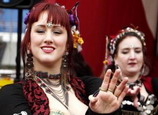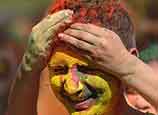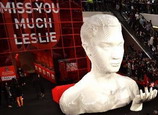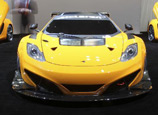
He played similar tricks in A Bath of Color Sensitivity. Cruz-Diez has hung four huge cylinders in midair that were formed by colored strips. People can walk inside the semi-enclosed space of red, blue, orange and green.
As a young graduate of a fine arts college in Caracas, Cruz-Diez believed that an artist's mission was to realize self-expression. He sought to document reality with thick and heavy brushes, in the magical culture of Latin America.
"It turned out, however, that my paintings only dropped into the stereotypes of aesthetics," he says.
"I don't want to be a craftsman of painting. Without ideas or thoughts to express, a painter can only use insignificant skills to repair the emptiness inside."
In 1952, he read Goethe's Theory of Colors, which aroused his early interest in the science of color. He found that color was a stimulating approach to perceive reality that he'd like to dig further into it.
In the following years he lived and worked between Paris and Caracas, exploring the relationships among colors, space, light and viewers' perceptions.
"Carlos Cruz-Diez is a thinker in the study of color," says CAFA's vice-president Xu Bing. "He has never stopped proving to the public one fact: That color autonomously exists and revolves without any support. With a scientific and rigorous attitude, he always challenges people's understanding of color."
He hopes the exhibition can inspire exchanges between Oriental and Western cultures.
"Black and white are the two most important colors in traditional Chinese art, while in my art research, all colors are equally important," Cruz-Diez says. "I wish Chinese audiences could feel in my works the splendor of color. Every one of us is a presenter of colors."

















 Exhibition marks 10th anniversary of Leslie Cheung's death
Exhibition marks 10th anniversary of Leslie Cheung's death


![]()
